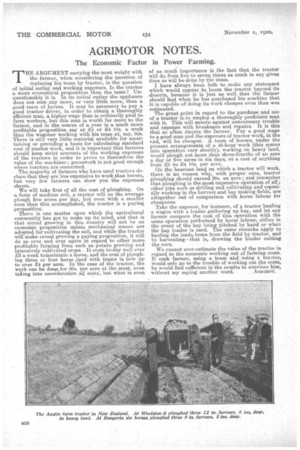AGRIMOTOR NOTES.
Page 26

If you've noticed an error in this article please click here to report it so we can fix it.
The Economic Factor in Power Farming.
THE ARGUMENT carrying the most weight with the farmer, when considering the question of replacing his team by tractor, is the question of initial outlay and working expenses. Is the tractor a more economical proposition than the team'? Unquestionably it is. In its initial outlay the appliance does not cost any more, or very little more, than a good team of horses. It may be necessary to. pay a good tractor driver, in order to obtain a thoroughly efficient man, a higher wage than is ordinarily paid to farm workers, but this man is worth far more to the farmer, and in the course of a year is a much more profitable proposition say at 24 or 24 10s. a week than the wagoner working -with his team at, say, 50s. There is still very little material available for ascertaining or providing a basis for calculating standard cost of tractor Work, and it is important that farmers should keep strict accounts of the working expenses of the tractors in order to prove to themselves the value of the machines ; guesswork is not good enough where tractors are concerned.
The majority of farmers who have used tractors declare that they are less expensive to work.than horses, but very few farmers can show you the expenses sheets.
We will take first of all the cost of ploughing. On a farm, of medium soil, a tractor will on the average plough five acres per day, but even with a smaller area than -this accomplished, the tractor is a paying proposition.
.There is one matter upon which the agricultural community has got to make up its mind, and that is that cereal growing in this country will not he an economic proposition unless mechanical means are adopted for cultivating the soil, and while the tractar will make cereal growing a paying proposition, it will do so over and over again in regard to ether more profitable farming lines such as potato growing and intensively cultivated crops. It costs to-day well over £2 a week toMmintain a horse, and the cost of ploughing three or four horse dand with teams is now up to over 24 per acre. Iri the case of the tractor, the work can be done for 30s. per acre at the most, even taking into consideration. all costs', but what is even of as much; importance is the fact that the tractor will do from five to seven times as much in any given time as will be done by the team.
I have always been loth. to make any statement which would appear to boom the tractor beyond, its deserts, because it is just as well that the farmer should find when he has purchased his machine that it is capable of doing its work cheaper even than was estimate&
The great point in regard to the purchase and use of a tractor is to employ a thoroughly proficient man with it. This will ensure against unnecessary trouble and expense with breakages and repairs. It is this that so often daunts the farmer. 'Pay a good wage to a good man and the expenses of tractor work, in the end, will be cheaper. A team of horses, under the present arrangements of a 48-hour week (this comes into operation very shortly), working on heavy land, would plough not more than three-fourths of an acre a day or five acres in six days, at a cost of anything from 23 to 24 10s. per acre.
On the heaviest land on which a tractor will work, there is no reason why, with proper care, tractor ploughing should exceed 30s. an acre ; and remember that ploughing is the most expensive operation of all ; other jobs such as drilling and cultivating and especially working in the harvest and hay making fields, are altogether out of comparison with horse labour for cheapness.
Take the expense, for instance, of a tractor hauling a wagon with a loader _gathering up hay, and let any farmer compare the cost of this operation with the same operation performed by horse labour, either in the event of the hay being pitched by hand or when the hay loader is used. The same remarks apply to hauling the loads.home from the field by tractor, and to harvesting—that is, drawing the binder cutting the corn.
We cannot over-estimate the value of the tractor in regard to the economic working out of farming costs. If each farmer, using a team and using a tractor, would only go to the trouble of working out the costs, he would find sufficient in the results to convince him,
without my saying another word. AGBIMOT.


























































